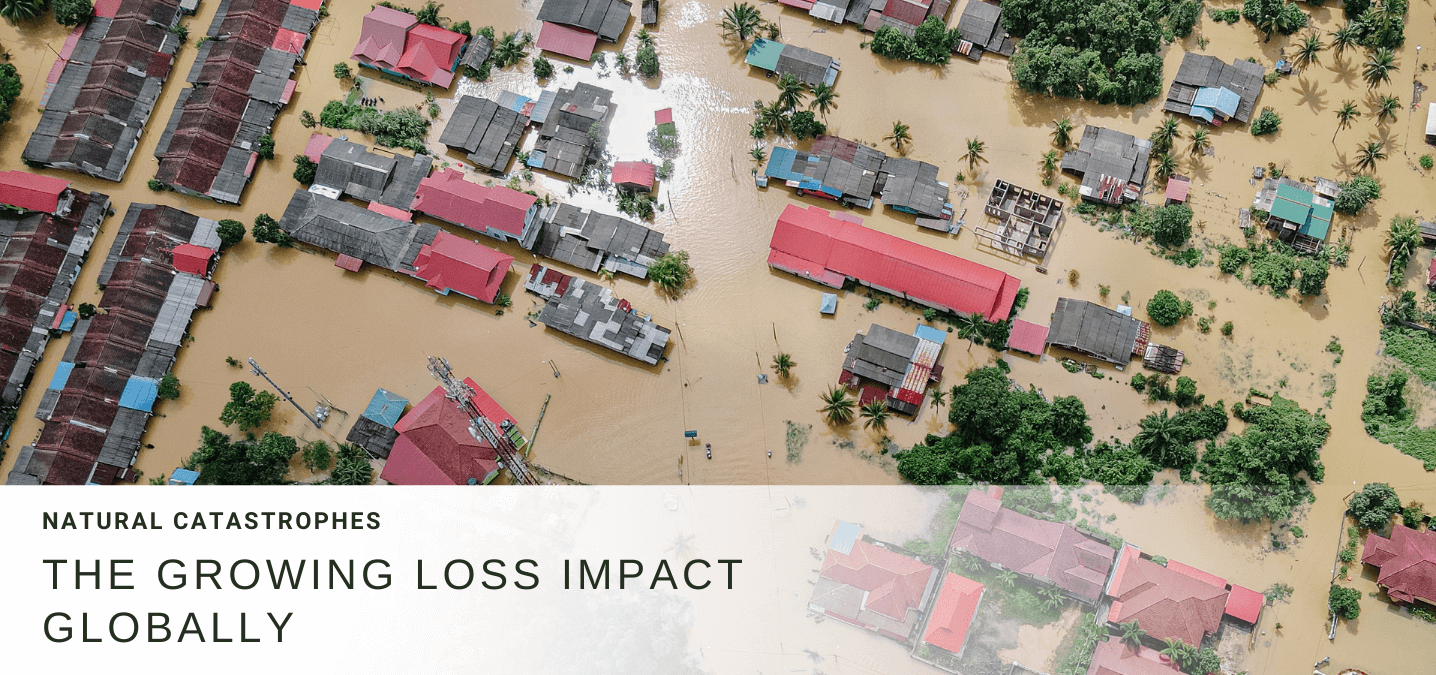

Climate change is continuing to drive more extreme weather events across the world, impacting people, communities and economies. The impacts are particularly prevalent in developing countries, which are more vulnerable to the effects of such extreme weather events. A recent report conducted by AON revealed that Asia Pacific accounted for more than US$15 billion worth of economic losses in the first quarter of 2022 because of natural catastrophes, higher than any other region.
Typically, natural catastrophe losses have been relatively low in the first quarter, with high loss years generally attributed to earthquakes, rather than weather-related events. However, there has been a shift in recent years with so-called ‘secondary perils’ now regularly contributing to a significant portion of losses.
The impact of such events is only going to grow as climate change worsens. Swiss Re Corporate Solutions reported that the number of natural catastrophe events and the size of the associated economic losses during the period of 2011-2020 is the greatest in the few decades since 1970. Whilst insurance markets around the world are getting more mature and there is higher insurance penetration in developing countries, Swiss Re Sigma and Guy Carpenter have both reported that there is still a 64% protection gap (the difference between economic losses and insured losses).
Natural catastrophe losses
Guy Carpenter reported that globally in 2021 the total losses from natural disasters were estimated to be approximately US$280 billion out of which US$120 billion were covered by reinsurance.
While the insurance gap has diminished in recent years in industrialised countries, there is still a considerable gulf between developing and emerging countries. It is often the case there that individuals and companies affected by a catastrophe have to carry on regardless and are forced to rely on donations from their own country or abroad.
While there are approximately 50%-70% uninsured losses for catastrophic events in the developed world, the protection gap in Asia is at a staggering 90%. For example, Japan, despite being the world’s third largest commercial insurance market in premium terms and being prone to the impacts of natural catastrophes, still had 74% (or US$260 billion) of its natural catastrophe losses uninsured over the last 10 years. Specific examples reveal the scale of the issue – the 2011 Tohoku earthquake/tsunami in Japan had overall losses of ¥16.9 trillion (US$210 billion) and only ¥2.7 trillion (US$34 billion) of these were insured.
It is important to narrow down the specific characteristics of natural catastrophe losses. They have large-scale damages involving thousands of properties/people, the insured loss runs in the millions or billions (creating an immediate need for response), there is a difficulty in accessing loss locations, a shortage in resources to deal with losses due to a surge in cases and dealing with the claims in a timely manner is crucial. Furthermore, most often there is a second or third wave of damage, particularly when it is caused by a flood or an earthquake.
Dealing with natural catastrophe claims
With the increasing risk of natural catastrophes, it is firstly important that businesses have disasters and business continuity plans in place with partners experienced in managing catastrophe claims, whether that’s locally, regionally or globally.
However, for the industry itself, forward planning is crucial. There should ideally be a pre-catastrophe agreement amongst insurers, reinsurers and service providers such as loss adjusters. The pre-agreement should cover areas such as adequate levels of personnel to be deployed, global loss adjusters often draw on international resources based elsewhere in the globe, pre-agreed rates and service level KPIs to be employed in natural catastrophe losses, pre-agreed levels of delegated authority, reporting procedures, provisions of digital reporting tools, 24/7 call centres, simplified e-FNOL (first notice of loss) forms, digital claim tools for affected policyholders and API connections to insurers database. Without pre-agreements, the situation can be extremely chaotic.
Claims strategy
The claims strategy to be deployed in a natural catastrophe situation will very much be driven and dependent on the line of business involved. This could be personal, commercial or industrial, and each call for a slightly different strategy.
Personal lines and small commercial claims: Generally, these claims are straightforward and involve damage to buildings and contents. The strategy deployed must focus on quick and efficient settlement of these losses. The faster the claims are settled the better the outcome will be for insurers, reinsurers, and policyholders. If the settlement of these claims is delayed, inevitably the loss amounts will increase. The insurance industry will also gain tremendous goodwill from affected policyholders for quick, efficient and hassle-free settlement of their losses. On the other hand, these claims will also lead to tremendous complaints and pressure from affected policyholders as their homes, personal property and businesses are affected. Digital claim tools are best deployed in the settlement of these lines of claims.
Commercial or industrial claims: These are generally more complex and involve massive business interruption losses. The 2011 Thailand floods are a good example of these types of losses. The losses can give rise to complex issues such as wide area damage, supply chain and contingency business interruption claims, denial of access and delays in reinstatement due to current global supply chain issues and war in Ukraine. Underinsurance is also prevalent given the current inflationary environment. The strategy deployed here must be to ensure the best and most qualified claims specialists and loss adjusters are handling these claims. It should involve widespread engagement with different experts, such as lawyers, restorers, forensic accountants and disaster mitigation specialists. Working as a team and having regular meetings with all stakeholders including insurers, reinsurers and brokers is a given. Managing these large losses requires a special skill set that only the best major complex loss adjusters can deliver.
The use of technology
Moving forward, technology and specific digital claims tools will become increasingly important in managing natural catastrophe claims.
Before incidents, GIS (geographical information systems) technology is used to map risk areas and possible loss exposures for underwriting, risk assessment and predictive capability. Knowing what risks are being underwritten, understanding the loss exposures and the potential impact of a wide-scale natural catastrophe event before the loss will no doubt aid underwriters and reinsurers to manage the loss more effectively.
More digital claims initiatives are now being deployed in the handling of natural catastrophe claims and these include digital FNOL tools, remote video surveys, digital apps that enable affected policyholders to “self-serve” and submit notifications and claims documents digitally, digital loss estimating systems and AI-enabled modelling software that enable accurate 3D modelling and loss estimation of affected areas and premises, increasing use of GIS (geographic information systems) enabled maps and databases to allow for better predictive analysis of natural catastrophe claims. These digital tools enhance the policyholder experience during such events and help expedite the efficient settlement of natural catastrophe claims.
It is undeniable that natural catastrophe claims will increase significantly in the coming years. The industry should be taking proactive steps to be prepared for an influx of claims in the future, whether this is through forwarding planning or growing technological solutions to improve the claims process.
 |
James Ong
CEO, Asia at Sedgwick
Mobile: +65 8126 9698 |
-
Allianz General | Allianz General combines innovative protection solutions while powering social good to lead Malaysian market
The insurer proactively addresses emerging risks and evolving customer protection needs while giving back to the community.
-
Sedgwick | Asia’s Energy Transformation – Balancing Growth, Risk and Renewables
Energy market presents unique risks, especially in a region which includes China and Japan as well as developing nations like Vietnam and the Philippines.
-
Beazley | Turbulent Waters: the maritime energy transition challenge
Businesses are facing a complex transition to non-carbon energy sources amid a push to achieve net-zero emissions for the marine sector by 2050.
-
Aon | Navigating shifts in the global and Asia insurance markets
Neelay Patel, Aon head of growth for Asia, says the market in Asia is at an ‘interesting stage of the cycle’.
